Cite this document
(Veteran Hiring in Federal Entities: Hiring Discrimination Assignment, n.d.)
Veteran Hiring in Federal Entities: Hiring Discrimination Assignment. Retrieved from https://studentshare.org/social-science/1822358-question-3
Veteran Hiring in Federal Entities: Hiring Discrimination Assignment. Retrieved from https://studentshare.org/social-science/1822358-question-3
(Veteran Hiring in Federal Entities: Hiring Discrimination Assignment)
Veteran Hiring in Federal Entities: Hiring Discrimination Assignment. https://studentshare.org/social-science/1822358-question-3.
Veteran Hiring in Federal Entities: Hiring Discrimination Assignment. https://studentshare.org/social-science/1822358-question-3.
“Veteran Hiring in Federal Entities: Hiring Discrimination Assignment”, n.d. https://studentshare.org/social-science/1822358-question-3.


